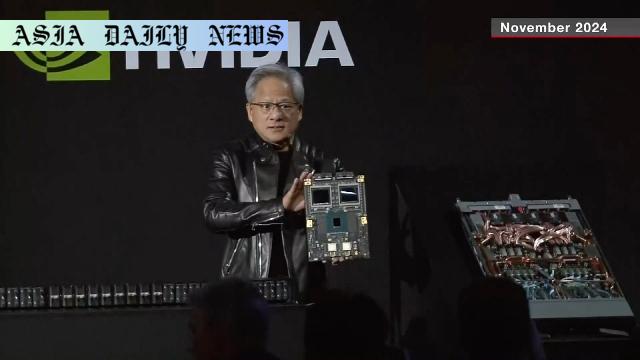Nvidia is moving to build chips and servers for AI entirely in the United States with a $500 billion investment.
Nvidia is shifting to domestic production of AI chips and servers entirely in the US to meet growing demand.
The company plans to invest $500 billion in AI infrastructure over the next four years.
Blackwell, Nvidia’s cutting-edge generative-AI chips, will be produced domestically in collaboration with manufacturing partners.
The move is expected to strengthen Nvidia’s supply chain and garner support for US semiconductor initiatives.

Introduction to Nvidia’s Bold Move
Nvidia, the global leader in semiconductor and artificial intelligence technology, has announced an ambitious plan to build its AI chips and servers entirely in the United States for the first time. This groundbreaking decision comes alongside a monumental investment of up to $500 billion over the next four years to revolutionize AI infrastructure. This initiative includes the domestic production of its advanced generative-AI chips, known as Blackwell, in collaboration with its trusted manufacturing partners. Nvidia’s efforts aim to address the ever-growing demand for AI chips and supercomputers while strengthening the company’s supply chain.
The Significance of Onshore Manufacturing
With global supply disruptions becoming more frequent, Nvidia’s decision to bring its AI chip production back to the United States marks a pivotal moment in the semiconductor industry. The COVID-19 pandemic, trade tensions, and geopolitical uncertainties have showcased vulnerabilities within global supply chains. By situating production domestically, Nvidia is poised to reduce dependence on offshore manufacturing, ensure supply chain security, and scale its AI infrastructure effectively to meet future challenges. American semiconductor policies under recent administrations, such as the drive to enhance homegrown chip production, further underline this critical shift.
What This Means for AI Infrastructure
Nvidia’s $500 billion investment will drive transformative changes in AI research, implementation, and development. With the domestic production of their Blackwell generative-AI chips at the forefront, researchers and developers will gain more reliable and readily available access to groundbreaking technology. As demand for AI applications, such as chatbots, machine learning platforms, and data analytics tools, continues to surge, Nvidia stands well equipped to lead this technological revolution. This investment not only fosters innovation but also creates numerous high-paying jobs and boosts economic growth within the United States.
Broader Implications for the Tech Industry
Nvidia’s strategic pivot aligns with broader efforts by the US government to rebuild and strengthen the nation’s semiconductor industry. Initiatives like the CHIPS Act signify a renewed focus on domestic chip production, maintaining technological supremacy, and reducing reliance on foreign suppliers. Nvidia’s leadership example could inspire other tech giants to prioritize domestic manufacturing as well. This shift, however, brings its challenges: ensuring adequate resources, skilled workers, and facilities to handle production demands, all of which must be planned meticulously.
Nvidia’s Role in Shaping the Future
As AI continues to reshape industries and redefine possibilities, Nvidia’s ambitious plans for domestic manufacturing represent more than just a shift in logistics—they mark a decisive step in shaping the future. Through its commitment to innovation and operational excellence, Nvidia not only cements its position as a leader in AI technology but also signals the importance of local production in maintaining a competitive edge in global markets. It is a testament to the company’s foresight and dedication to growth.
Conclusion
Nvidia’s decision to invest $500 billion in AI infrastructure and shift production of its generative-AI Blackwell chips to the US is nothing short of transformative. By reducing reliance on foreign manufacturing, strengthening its supply chain, and providing cutting-edge AI technology domestically, Nvidia redefines industry standards. This move highlights the importance of proactive investment, robust planning, and innovation to optimize the potential of artificial intelligence. It’s a bold step forward, not just for Nvidia, but for the US semiconductor and AI industries as a whole.



Commentary
An Industry-Leading Decision
Nvidia’s decision to produce AI chips and servers entirely within the United States comes at a pivotal moment for the tech industry. This move not only reflects the growing demand for AI but also highlights Nvidia’s commitment to innovation and leadership within the semiconductor market. Their ambitious $500 billion investment shows their drive to create a sustainable, secure, and highly efficient supply chain—a critical factor in a rapidly evolving technological landscape. With AI’s potential reaching new heights, Nvidia’s plans serve as a model for other corporations to invest in their domestic capabilities.
Rebuilding Trust in US Manufacturing
In recent years, challenges in global supply chains have exposed vulnerabilities in key sectors. Nvidia’s efforts to bring high-tech production back to American soil signal a renewed belief in domestic manufacturing capabilities. While pragmatic, this shift aligns seamlessly with government policies aimed at boosting US semiconductor production. The ripple effects from Nvidia’s investment will not be limited to the company itself; it will contribute to job creation, skill development, and economic revival in local communities.
The Long-Term Implications for AI
The scale and scope of Nvidia’s investment promise to create a solid foundation for AI innovation. By ensuring high-quality production of Blackwell chips domestically, Nvidia will enable researchers, developers, and companies to access next-generation tools that power AI advancements. Beyond strengthening their hardware portfolio, this shift reaffirms Nvidia’s status as a thought leader capable of navigating economic, political, and technological landscapes. The world is watching closely, and Nvidia is undoubtedly setting the standard for what’s to come.